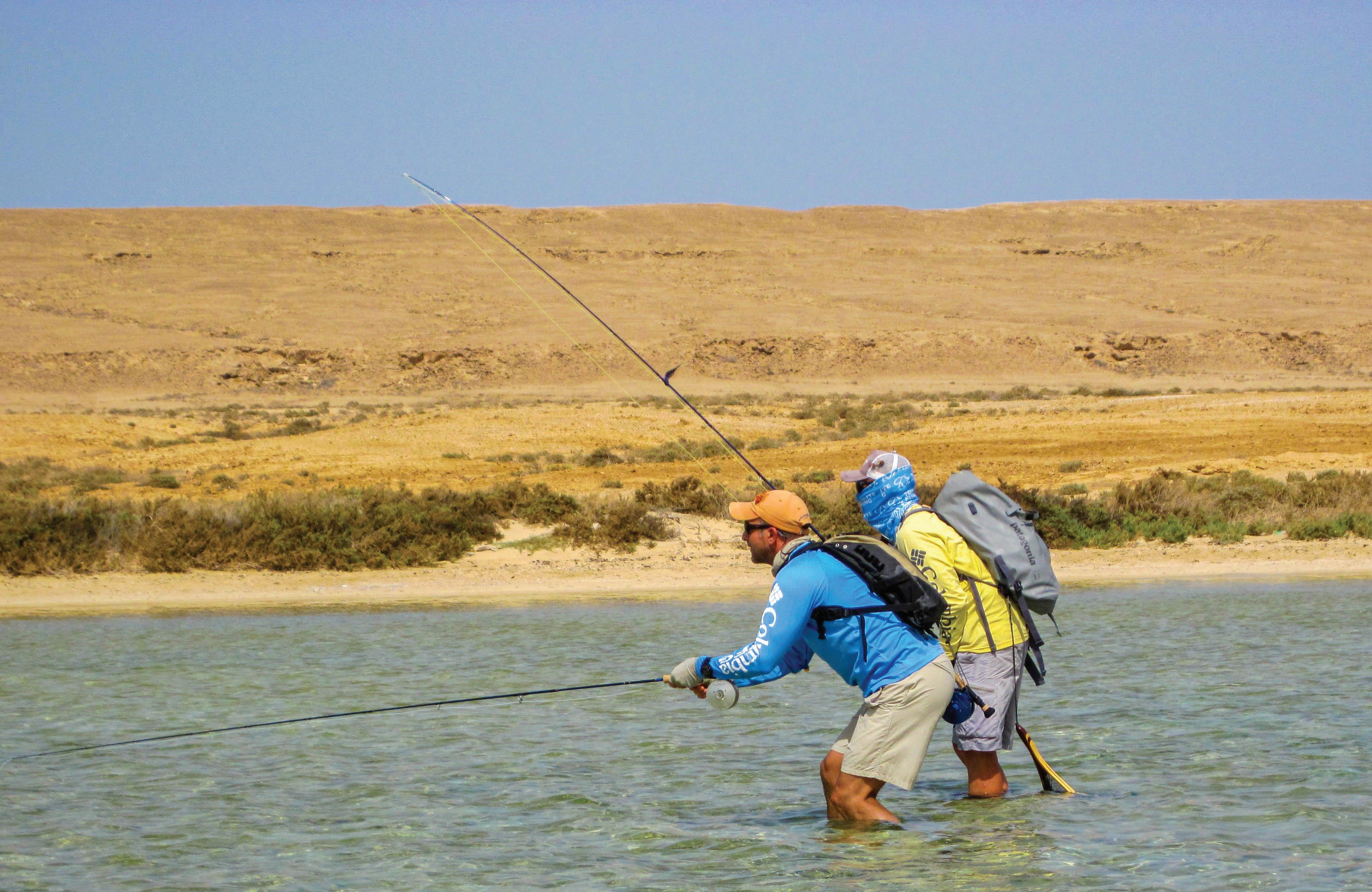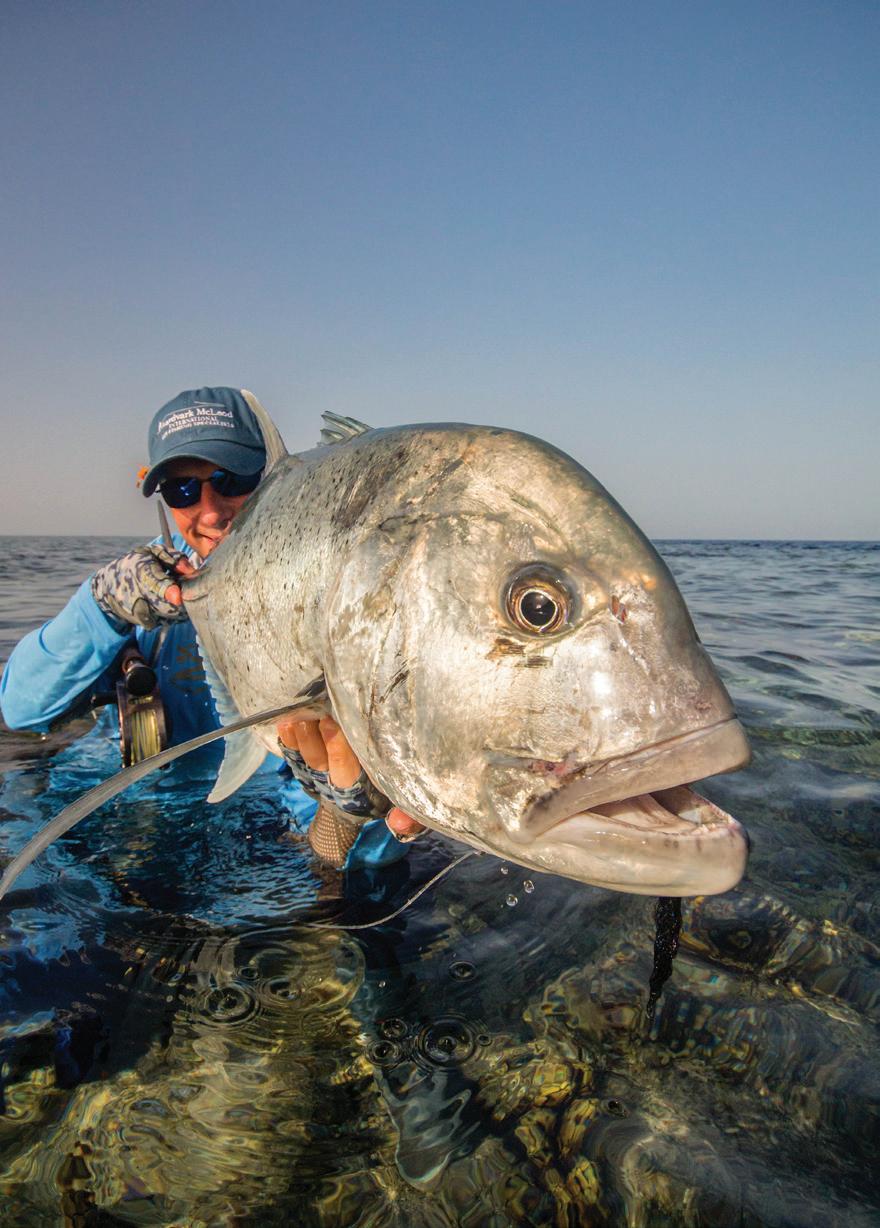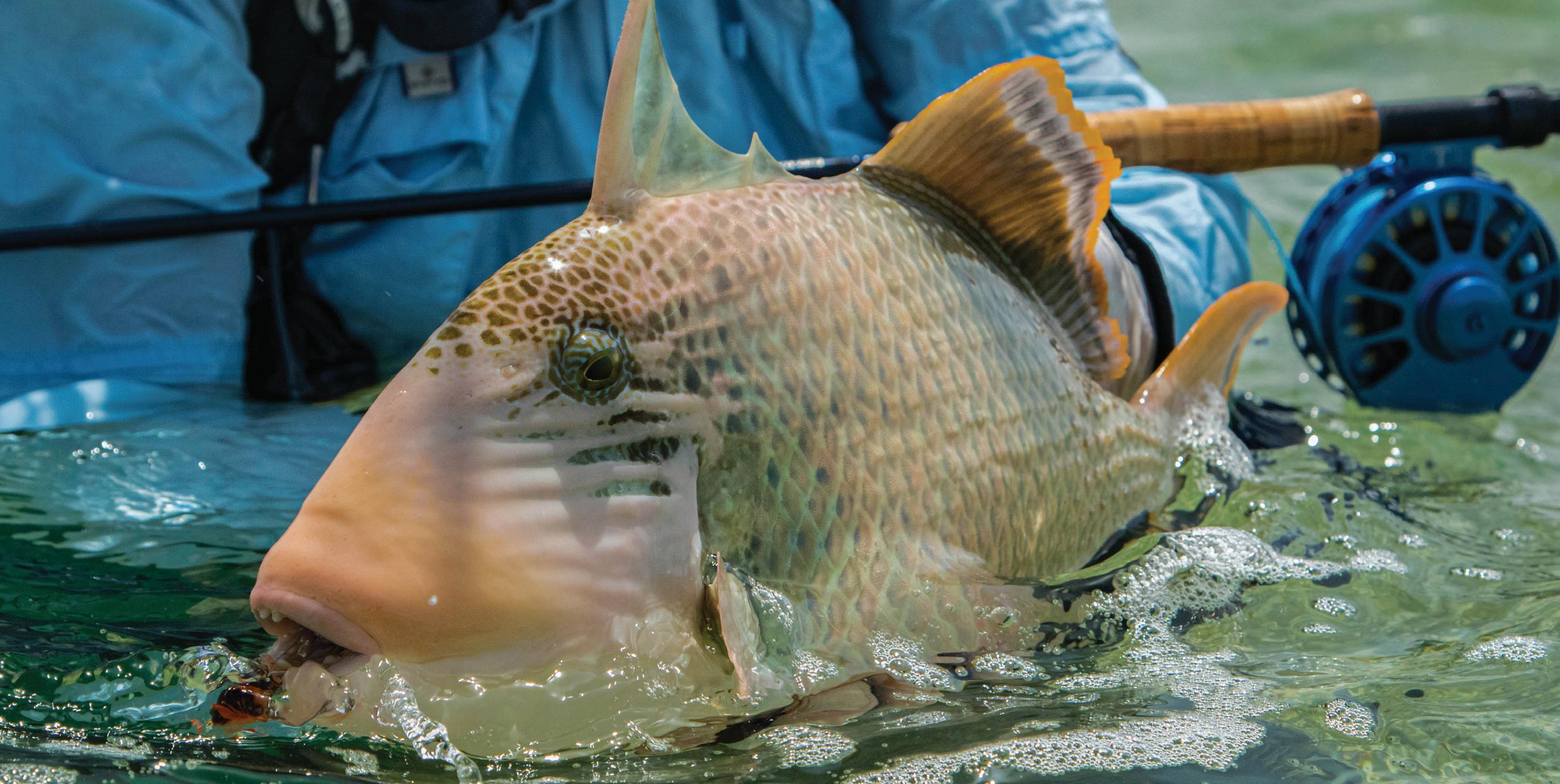
14 minute read
NUBIAN ADVENTURE
AdventureNubian





by Peter McLeod
When one thinks of saltwater flats destinations, Sudan is hardly a location that springs to mind. In fact, pretty much the opposite. When the Nubian Flats operation was launched a few years ago, reports began to trickle through of giant deserted flats teeming with fish. There appeared to be a very high density of triggerfish, good numbers of bohar snapper, bluefin trevally, and, as an added bonus, a few giant trevally. I’m always on the lookout for new adventures, and the thought of an untapped saltwater destination full of triggerfish thrilled me. If you’ve ever fished for triggers, you know what an obsession they can be—sort of like permit. But Sudan…? My limited knowledge about this part of the world immediately made me nervous, as most news reports of Sudan are hardly favorable. I began to research it and discovered I was very wrong. Sudan is a huge country. It’s 1,200 miles across, and the area that’s troubled is an entirely different country: South Sudan. The distance from this area to the Red Sea is 1,100 miles. The more I understood about the area the fewer worries I had.
The coastline this operation explores runs from the Egyptian border south to the Eritrean border. It encompasses some 300 miles of islands, flats, and pinnacles surrounded by some of the clearest oceans and the best diving in the world. This coastline is, for the most part, deserted, as it is the Nubian Desert. It’s inhabited by nomadic populations of camel and goat herders, and there are no fishing communities. This is key, as aside from a handful of small open boats using hand lines, there is no fishing pressure. This sounded more interesting by the minute. I put together a team of six anglers to go and explore the potential this fishery might have. What we found was very exciting indeed!
The route to Sudan is extremely simple, with a direct flight to Dubai on Emirates followed by a connecting flight to Port Sudan with Fly Dubai on a brand new 737-800. We left on a Sunday night and on Monday afternoon found ourselves at the desert airport of Port Sudan. Our team was met by Tourette Fishing’s ground handlers, who showed us to a minibus. Our bags were loaded into the back and we headed off across the desert to the coast. A 20-minute drive had us in the town of Port Sudan, and then we proceeded north along the coast for 2 3/4 hours through some of the most extraordinary landscape I’ve seen. Wild desert with huge, jagged mountains were visible in the distance through a haze of dust and heat; this was punctuated by a few patches of scrub, goats, and a few camels wandering about. As the sun began to descend behind the mountain


range we turned off the road toward the sea and the largest port in the north, Muhammad Qol. That Muhammad Qol is the largest port in the north is somewhat ironic, as it’s a tiny community of sandy streets that lead to a military outpost of two jetties and a handful of boats. The soldiers on this outpost mostly wore football shirts from Arsenal, Barcelona, and Real Madrid, which was somewhat surreal....
Here we laid eyes on our home for the week, the 60-foot motor catamaran Scuba Libre. As tenders, she has two 23-foot fiberglass pangas equipped with 30- and 40-horsepower two-stroke engines. Met by the guide team from Tourette Fishing, our team was ferried across with our luggage. Cabins were quickly allocated, and then head guide, Mark Murray, briefed us on the week to come over a much-welcomed cold beer. Murray introduced us to Federico (Fede) and Stuart Harley (Stu), who would be our guides for the week. That night we would stay in port before heading out to our first anchorage at Magarsum Island; then we’d continue to move to further anchorages, exploring the flats as we went.
Although everyone had a cabin, the guides and crew slept topside along with most of the anglers. It can get very hot downstairs, even though each cabin had a fan, and most prefer sleeping on deck in the open air under the carpet of stars. As we drifted off to sleep, we reveled in the gentle offshore breeze and the sound of lapping water—a total contrast to our normal lives.
The first morning dawned crystal clear and flat calm. The water clarity was astounding, and as we stepped out onto the beach I felt a thrill of excitement pulse through me. The flat was some 250 yards wide from the beach edge to the reef, dropping off into aquamarine water with the red mountain of the island in stark contrast climbing up to our right. As we lined up across the flat and proceeded to wade slowly north, what ensued was staggering. The flats were crawling with triggers: titans and yellow margins tailing on the mixture of coral and weed. If you’ve fished for triggerfish before, you’re fully aware that just because there are many fish present doesn’t necessarily mean you’ll catch many! They’re tricky little guys, each with an individual personality. Sometimes it’s not about finding the right fly but about finding the right trigger.
The three of us had many shots, follows, and near misses. Some of the titans were huge, their orange spade tails waggling in the morning sunlight like small flags.
Although I saw fewer in the shallows, my fellow anglers had many shots in the slightly deeper water. The yellow margins, although numerous, were behaving oddly. Pairs chased each other around and daisy chained. Mark believed this was part of their spawning ritual, making them especially spooky. (Apparently the reverse had been the case earlier in the season with the titans behaving that way in March and early April.) I spotted two titans tailing in a small depression and dropped the fly off to the right. After letting it sink, I gave the Gumby Crab one small twitch and a large titan charged over to investigate. It tailed on the fly three times as it followed it toward me and I could feel the trigger nipping as I maintained contact with slow strips. Finally, everything went tight and he was on. I felt the weight and then, as if on cue, the fish spat the fly back at me, nearly hitting me in the face! The afternoon session blew my mind, with at least 15 tailing triggers along the edge, some the size of footballs. Again, the excitement of follows and near misses. Finally I found a lovely titan tailing between me and the bank. I moved into position and dropped the Gumby Crab 10 feet to the left on a backhand delivery across the breeze. The aggressive titan did exactly what it was supposed to do: It charged over and hit the fly like a ton of bricks and I was in! As it tore off toward the coral edge, I began to pump it on my 8-weight Hardy. I was using a Rio saltwater tapered leader with 2 feet of 19-pound Seaguar fluorocarbon tippet— so I knew I was safe. I quickly landed my first Nubian Flats trigger of about 6 pounds. Nowhere in the world had I ever encountered numbers of triggerfish like this. It was akin to fishing for bonefish in the Caribbean. Suddenly Mark indicated for us to stop. There, just ahead of us, was a school of tailing permit. We stood like statues as one of the group cast out a stunning line that dropped the fly gently near them. One of the fish dropped its tail immediately to scurry over and tail on the fly. No one uttered a word. Our hearts were thumping in our chests as he took up the slack … and nothing…. Arrrgh! Permit are the same wherever you are in the world, but that was about as good an opportunity as anyone would get.


We continued up the flat, and as I was scanning around I had a quick look behind me and suddenly there was an explosion of water. A giant trevally had snuck up on me, probably thinking I might make a good meal, before charging off the edge of the flat. As the light faded and it was time to head home, our team estimated we had between 15 and 20 shots each. We had tried every fly in the box. “Sometimes it’s not the wrong fly but the wrong trigger”—a saying that would be coined on this trip. We all collapsed into bed that night and drifted off to sleep dreaming of little flags waving in the ripple.
Each day the sun would jump into the sky like an orange football against the backdrop of the red sand mountains, and our little groups would take to their boats like some kind of dawn raiding party as we hit the flats for the next chapter of the adventure. As with all fishing trips, the days blur into memories. It’s difficult to give the full flavor of a trip such as this, but I’ll try to recount a few anecdotes that have remained imprinted on my mind. One evening as the light began to dip to a ball of red, a small band of us were fishing off the Eastern edge of Shambaya, a huge open white sand flat. The coral edges here are treacherous; due to the lack of tidal fluctuation in the Red Sea, the coral is covered in algae. These were perhaps the most uneven, slippery, difficult edges I have ever waded—not for the fainthearted. The guides have taken to wearing felt-soled leather wading boots for this destination, and I quickly discovered that my normal Simms Flats Sneakers, although tough enough, were pretty slippery. While we were fishing the edge of the drop-off, a large bohar snapper erupted out of nowhere, snaffled Phil’s fly, and disappeared. Wow! Yay! … Oh…. Stu (nicknamed Aqua Boy after his consistent donning of mask and disappearing to retrieve fish) came to the rescue. He swam out over the edge, and as Phil braced himself to resume battle, Stu suddenly erupted from the water like Poseidon holding the enraged bohar over his head. Shortest bohar battle known to man.
The Nubian Flats have a very fair giant trevally fishery. On another occasion, four of us motored out to Angorosh, an impressive rock pinnacle encircled by a small flat that drops away to 600 feet of water. We intended to stake out and wait

for the GTs to come hunting. There was amazing light with stacks of baitfish on the east side, piled against the trough by the rising surf. I saw GT coming along the edge, tried to cast backhand into wind, but I couldn’t get a reasonable shot. Ten minutes later, Phil came running down the beach toward me as another big GT cruised the edge with a big bluefin trevally in tow. Phil got the shot, and the fish chased the fly but infuriatingly turned off at the last second. We waded out to the drop-off to fish over the edge and got battered in the surf that was now coming in from the brisk breeze. I found a suitable coral bommie to stand on and put a blind backhand cast to my right, let the fly sink and started to retrieve.
Bang! A massive yank and I was nearly pulled straight off my bommie. I staggered through the surf to the edge to stop from being cut off on the coral. Fede, my guide, rushed to aid me and managed

to free line that was wrapped around a coral head. As I looked over the edge into the blue below I was astounded to see the GT I had hooked was just one of a school of nearly 50 fish! After some grunting, sweating, and clenched teeth, I managed to pull it up and over the edge. The fish swam a big circle around me back onto the flats before trying to head back to the drop-off. Finally I brought it to hand, a lovely GT of 27 inches.
Those who’ve known me are aware there’s one species that I’ve always had issues with: the yellow margin triggerfish. Over the years I’ve very happily caught some lovely titan triggerfish, but somehow whenever the yellow margins are around things just don’t seem to go according to plan. I’m sure many anglers suffer similar afflictions with a nemesis species—and the longer it continues the worse it becomes. This affliction began for me with one particular yellow margin here on the Nubian Flats of Sudan—and this is how the story unfolded….
I had been wading a very large open sand flat where the triggers had been skittish. I finally made it up to one of the sandy islands to find two massive yellow margins tailing against the sand drop with a nice current flowing over them—much like trout in a stream. I successfully spooked both and was beginning to feel I was cursed with this species. As I very slowly waded down to the bottom of island, there, on the white sand, was a massive yellow margin tailing happily away. I switched to a light Cuban Shrimp, hoping the quiet presentation would make the difference. As soon as the fly landed the fish came straight over and began following the fly, nipping at it. I continued to slowly draw the fly toward me with long slow strips and finally the trigger crushed it and I hooked up! Yes! The trigger looked very confused, did a
big backpedal with its pectoral fins and spat the hook back at me. Aarrrgh!
As I was down on one knee, the fish did not spook, so I cast again. Again, it charged up, chased the fly and everything went tight. I raised the rod, tightened up, and it was on! Yes, got the yellow margin—or so I thought…. After a few seconds the trigger did exactly the same thing: did a backpedal with its pectoral fins and spat the hook back at me. I have to say, I very rarely lose my temper when fishing, but in a moment of extreme anguish I might have uttered some bad language and I might have thrown my rod in the water…. My fishing partner had witnessed the event and tactfully turned around to “check something” while I had my temper tantrum. It just goes to show that our finely honed hooks are really nothing more than toothpicks to these coral-crunchers. I calmed down, and as the fish was now headed toward my fishing partner I requested politely that he catch it for me, as I appeared to be inept. He turned around, and after a couple of minutes and some follows he hooked up and managed to land the fish, a serious specimen. I suppose some might have been jealous, but I was just delighted that it had not made a fool of both of us!
For me this was an extraordinary trip that far exceeded my expectations. There are some important points to note. Triggerfish are not easy. That is the same anywhere you go in the world: There is no quick fix in catching numbers of them. Each fish has its own personality and behavior— and they’re smart. The fishing is technical and can be frustrating, but you’ll have more opportunities in Sudan over a prolonged period of time than anyplace else in the world I’ve encountered. The lack of tidal flows expands the windows of opportunity dramatically, and there are some truly massive triggers here. Triggers are the prime target and the GTs, I believe, should be considered a bonus and not a certainty. Fishing for GTs is difficult, and in difficult conditions. The coral is unforgiving, so you can expect to hemorrhage terminal tackle. To make this trip you need to be prepared for that and pack accordingly.
We fished only one area along a 300mile coastline, so I’m excited about the fishing opportunities that Sudan holds for the future. This trip is by no means for everyone, but if you love triggers and the possibility of some GTs and other trevally species in a deserted part of the world, this could just be the adventure you are looking for.
TFFM’s Travel Editor, Peter McLeod, is the founder of Aardvark McLeod, international fly fishing specialists. For more information on fly fishing Sudan—or any other international destination—you can contact Peter at peter@aardvarkmcleod. com or visit his website at www. aardvarkmcleod.com.






